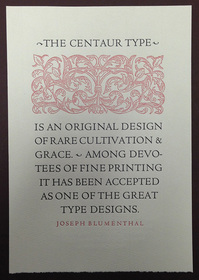
In Shakespeare’s Julius Caesar, Mark Anthony names Brutus the “noblest Roman of them all.” New in Special Collections, The Noblest Roman: A History of the Centaur Types of Bruce Rogers (Z232 R67 K45 2016) offers another candidate for that title. Created in the early 20th century by Bruce Rogers, a celebrated American typographer who favored classical design, the Centaur typeface harkens back to type used in the incunabula period of printing. The name comes from the title of the first book printed using the type: The Centaur, by Maurice de Guerin, in 1915.
Here is high praise for the typeface from the Introduction, p. 11: “It will depend upon the skill and talent of the typographer to deliver the words to the reader, much like a musician interprets music for the listener…. The greatest achievement in typography, then, is to create the best-tuned instrument, capable of playing a tune at “perfect pitch.” The challenge is to do so with elegance, grace, and style, much like a musician. The Centaur type of Bruce Rogers is such an instrument: it possesses a degree of dignity and grace that is as sublime as it is impossible to replicate.”
 :
:
Besides the examples of Centaur typeface you will see in this slim volume, Special Collections holds many examples of books using the Centaur font and of titles printed by Bruce Rogers.
Kelly, Jerry and Misha Beletsky. The Noblest Roman: A History of the Centaur Types of Bruce Rogers. San Francisco: The Book Club of California, MMXVI [2016].










